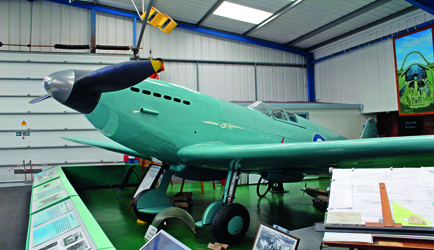Articles
Record breaker: The Hawker Hunter Mk 3
Just a few miles east of Chichester lies the West Sussex village of Tangmere, famous for the airfield that was instrumental in winning the Battle of Britain.
RAF Tangmere was founded in 1917 as a training base. During the second world war it was enlarged so it could help to defend the south coast from the German Luftwaffe. Secret agents were also flown from here on missions to aid the French Resistance.
In a corner of the old airfield is Tangmere Military Aviation Museum, which opened its doors in 1982. Staffed by volunteers, it celebrates military aviation heritage and serves as a memorial to the people who gave their lives for their country.
The museum’s Battle of Britain exhibition charts the air campaign against the Luftwaffe that summer of 1940. Memorabilia displayed here include airmen’s signatures, poems and uniforms and fragments of Junkers Jumo and Rolls-Royce Merlin and Griffon V12 engines.
One notable item here is the wreckage of a Hawker Hurricane Mk 1 fighter flown by Sergeant Dennis Noble. Noble – aged just 20 – was shot down over East Sussex by a Messerschmitt in 1940, and remained buried with his plane for 56 years until they were excavated.
Those with a keen interest in the airfield’s history will find a wealth of information in the museum’s Tangmere Hall section, together with exhibits ranging from paintings and maps to pilots’ goggles and radio equipment.
The nearby Merston Hall houses an impressive collection of record-breaking aircraft, including the Gloster Meteor F4 jet flown by Group Captain Edward ‘Teddy’ Donaldson in 1946 when he set a world air speed record of 991km/h.
In the corner of the hangar is an ‘all red’ Hawker Hunter Mk3, in which, six years after Donaldson’s achievement, Squadron Leader Neville Duke broke the record by hitting 1,171km/h. The eye-catching Hunter was one of only three prototypes made, and later became a Mk 3 variant when upgraded with side-mounted airbrakes, extra fuel tanks in the wings and a new Rolls-Royce Avon RA7R engine.
Other interesting planes in the Merston Hall section are a Hawker Hurricane Mk1, 1950s Vickers Armstrong Supermarine Swift FR5 reconnaissance plane and a stunning Supermarine Spitfire prototype replica completed in the 1990s. As well as the aircraft, you’ll find a cockpit from an English Electric Canberra plus cut-away jet engines and an array of propellors.
Not to be missed are two aircraft in the adjacent hall: a Hawker Hunter Mk 5 and an English Electric Lightning F53 – arguably the finest jet interceptor of its era.
The museum also has several flight simulators where visitors can test their skills, including a WWII fighter cockpit from which you can test your mettle in air-to-air combat. However, it’s the Hawker Hunter Mk 4 cockpit – with a mind-boggling array of gauges, switches and levers – that looks particularly inviting, albeit somewhat terrifying.

Star of WWII: A Supermarine Spitfire prototype replica in Merston Hall
5 things to see
1. Sergeant Dennis Noble’s Hurricane: Noble was shot down after just 27 days on active duty.
2. Gloster Meteor F4: See the aircraft that captured the air speed record.
3. Hawker Hunter Mk 3: This 1950s jet fighter is distinguished by its pointed nose cone.
4. Supermarine dream: See a prototype replica sponsored by members of the original design team and the Spitfire Society.
5. Flight of the navigator: Put your fingers on the trigger inside a flight simulator.
For opening times and more information see: www.tangmere-museum.org.uk